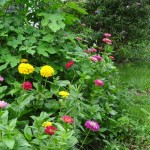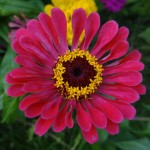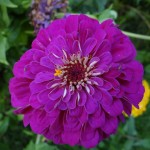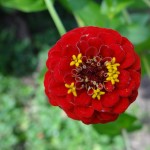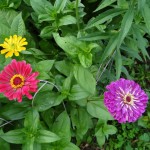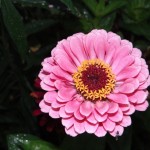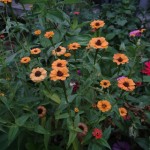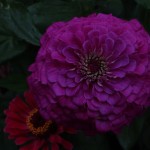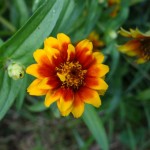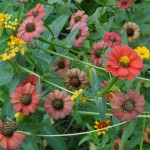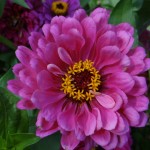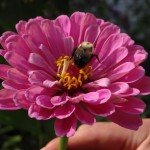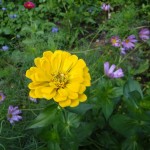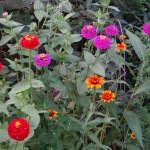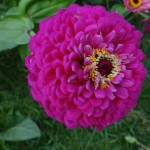I’ve heard people say that zinnias are a flower that elicits strong reactions; you love ’em or you hate ’em. Seriously, what’s there to hate? They’re easy to grow, they are annuals that bloom their fool heads off for months, they attract hummingbirds and butterflies, they make cheerful, lasting flower arrangements and they come in a host of sizes, shapes and colors. Good golly!
I plant them yearly, at least a flat’s worth of different varieties I’ve started from seed. This spring I sited them in an area that has somewhat skimpy amended soil–there used to be overgrown junipers in that spot–so the soil isn’t very deep. They still took off like gangbusters. If I erred, it was that the sun changes its angle over the seasons so they got a bit leggy trying to maximize their access to the rays. Elsewhere, they would have stood straighter and even bushier.
Zinnia is the name of the genus; the name honors a famous German botanist:Johan Gottfried Zinn. They are a member of the sunflower family (Asteraceae), tribe (Heliantheae). Their origins hale from Mexico and lead toward the southwest and down to South America– sunny, arid scrub and grasslands.
Thomas Jefferson grew Zinnia peruviana and Zinnia pauciflora which are both smaller flowered and have different looking petal arrangements than the modern cultivars. Zinnias did not achieve popularity in gardens until late 19th century. Now there are a whole host of species and cultivars to choose from.
This year I planted Zinnia elegans cutivars “Cool Crayon” and “Hot Crayon Colors” and “Berry Basket” plus Zinnia augustifolia Profusion series. I also have a few “Old Mexico” and “Persian Carpet” that are very small flowered and low growers.
It is recommended to space your zinnias to cut down on mildew and fungus issues and to keep the flowering going to snip off flowers that are getting high centered with only a a row or two of petals.
- First zinnias of 2013
- My zinnia path
- Spoon shapes
- Deep purple
- REd Min-zin
- Bright tones
- Mid pink zin
- Orange profusion
- Zin at dusk
- Small Old Mex
- Profusion changes tones when aging
- Plethora of zinns
- Beautiful corrolla
- Bumble zin
- Bright yellow zin
- Bitty zinns
- Petalacious!
- Berry tones
- Still available for Sept monarchs

